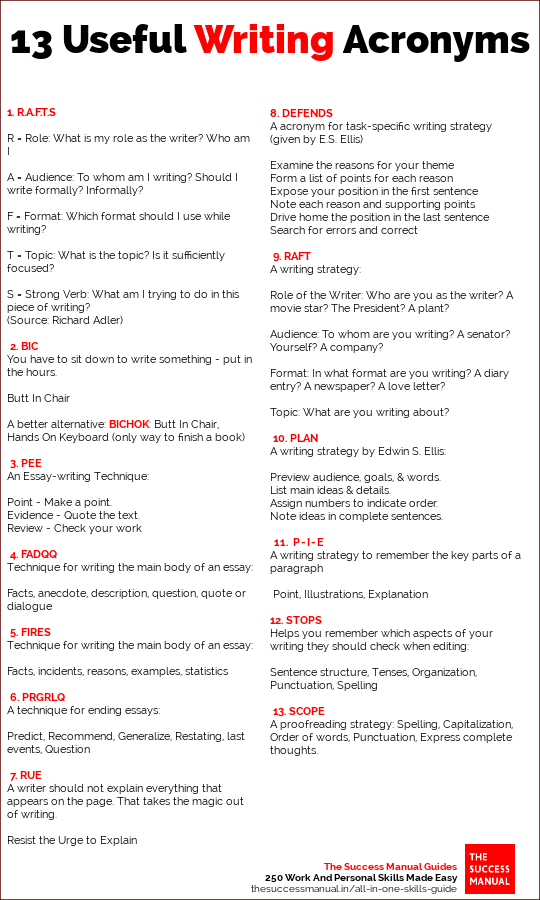13 Useful Writing Acronyms
Writing skills | Acronym definition
1. R.A.F.T.S
R = Role: What is my role as the writer? Who am I
A = Audience: To whom am I writing? Should I write formally? Informally?
F = Format: Which format should I use while writing?
T = Topic: What is the topic? Is it sufficiently focused?
S = Strong Verb: What am I trying to do in this piece of writing?
- Richard Adler, Writing Together
2. BIC
A big tip for writers: You have to sit down to write something - put in the hours.
Butt In Chair
A better alternative: BICHOK: Butt In Chair, Hands On Keyboard (only way to finish a book)
3. PEE
An Essay-writing Technique:
Point - Make a point.
Evidence - Quote the text.
Review - Check your work
4. FADQQ
Short for a technique for writing the main body of an essay:
Facts, anecdote, description, question, quote or dialogue
5. FIRES
Short for another technique for writing the main body of an essay:
Facts, incidents, reasons, examples, statistics
6. PRGRLQ
Short for a technique for ending essays:
Predict, Recommend, Generalize, Restating, last events, Question
7. RUE
A writer should not explain everything that appears on the page. That takes the magic out of writing.
Resist the Urge to Explain
8. DEFENDS
A acronym for task-specific writing strategy (given by E.S. Ellis)
Examine the reasons for your theme
Form a list of points for each reason
Expose your position in the first sentence
Note each reason and supporting points
Drive home the position in the last sentence
Search for errors and correct
9. RAFT
A writing strategy:
Role of the Writer: Who are you as the writer? A movie star? The President? A plant?
Audience: To whom are you writing? A senator? Yourself? A company?
Format: In what format are you writing? A diary entry? A newspaper? A love letter?
Topic: What are you writing about?
10. PLAN
A writing strategy by Edwin S. Ellis:
Preview audience, goals, & words.
List main ideas & details.
Assign numbers to indicate order.
Note ideas in complete sentences.
11. P-I-E
A writing strategy to remember the key parts of a paragraph
Point, Illustrations, Explanation
12. STOPS
Helps you remember which aspects of your writing they should check when editing:
Sentence structure, Tenses, Organization, Punctuation, Spelling
13. SCOPE
A proofreading strategy: Spelling, Capitalization, Order of words, Punctuation, Express complete thoughts.
❤ If you liked this, consider supporting us by checking out Tiny Skills - 250+ Top Work & Personal Skills Made Easy
